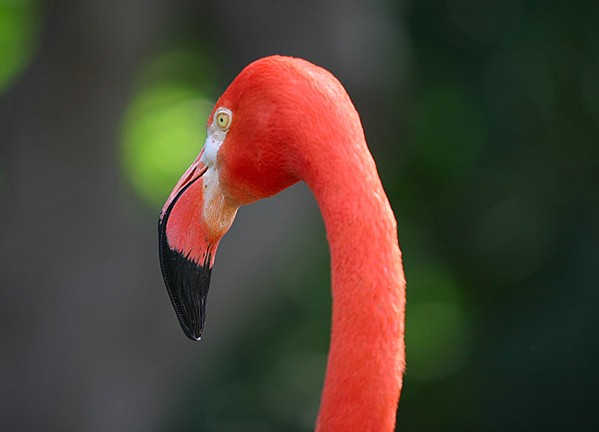Lessico
Fenicottero
Phoenicopterus
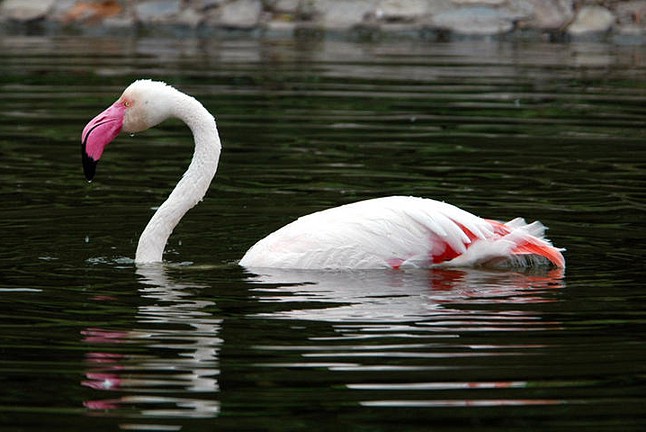
Fenicottero significa dalle piume rosse, o meglio,
dalle piume color rosso sangue (arterioso o venoso?), in quanto il sostantivo greco φοῖνιξ, che indica la porpora, deriva dall'aggettivo
φοινός che significa rosso sangue, a sua volta derivato
dal sostantivo φόνος che significa omicidio. E il vocabolo φοῖνιξ entra appunto nella composizione dell'aggettivo greco φοινικόπτερος, che significa
dalle piume color rosso sangue, non color porpora, come sono invece quelle del
pollo sultano, Porphyrio porphyrio![]() . Su quale sia
il vero colore della porpora, primo significato posseduto da φοῖνιξ, potrete annoiarvi leggendo la lunga disquisizione nel capitolo relativo al
colore del guscio dell'uovo di gallina nella storia
. Su quale sia
il vero colore della porpora, primo significato posseduto da φοῖνιξ, potrete annoiarvi leggendo la lunga disquisizione nel capitolo relativo al
colore del guscio dell'uovo di gallina nella storia![]() .
.
I Fenici - Φοίνικες - furono maestri nella produzione e nel commercio della porpora, dalla quale trassero il nome. Quello della porpora è stato uno dei brevetti e monopoli industriali meglio mantenuti e difesi di tutta la storia. La produzione della porpora, diventata più stretta esclusiva dei Fenici dal 300 aC al 150 dC, era un’attività che ancora persisteva all’epoca di Carlo Magno (VIII secolo), ma poco dopo andò persa.
In italiano il fenicottero era anche detto fiammingo, termine derivano dal provenzale flamenc, forse da fiamma, quindi, dalle piume color fiamma. Tant'è che il fenicottero in inglese è detto flamingo e in francese flamant.
Flamenco
non ha nulla a che fare con la fiamma o con la porpora: viene dallo spagnolo flamenco,
cioè fiammingo (delle Fiandre, flaming in antico olandese), termine
con cui si designarono, a cominciare dal primo terzo del sec. XIX, i canti e i
balli (cante flamenco, baile flamenco) dei gitani andalusi. Non
chiedetemi il perché di questo nesso etimologico tra Andalusia e Fiandre![]() .
Oltretutto gitano è da correlare al latino parlato Aegyptianus =
egiziano, e i gitani sono quel gruppo di emigranti Rom (nel loro
idioma il termine rom, insieme a manush, indica uomo) che
dall'India raggiunsero la Spagna attraverso l'Egitto.
.
Oltretutto gitano è da correlare al latino parlato Aegyptianus =
egiziano, e i gitani sono quel gruppo di emigranti Rom (nel loro
idioma il termine rom, insieme a manush, indica uomo) che
dall'India raggiunsero la Spagna attraverso l'Egitto.
Invece
l'aggettivo φοῖνιξ è fondamentale per l'etimologia dell'uccello
mitologico Fenice. Se ne disquisisce a proposito dei polli dalla lunga coda
detti Phoenix in inglese![]() . In sintesi, eccone la motivazione: Patrick Houlihan in The birds of ancient Egypt
(1988) afferma che in Egitto l’airone, o benu, equivalente mitologico
della fenice, veniva frequentemente raffigurato in blu, ma egli presume che il
modello pittorico principale per il benu fosse rappresentato
dall’airone cinerino, Ardea cinerea. Secondo altri il benu
corrispondeva invece all’airone rosso, Ardea purpurea.
. In sintesi, eccone la motivazione: Patrick Houlihan in The birds of ancient Egypt
(1988) afferma che in Egitto l’airone, o benu, equivalente mitologico
della fenice, veniva frequentemente raffigurato in blu, ma egli presume che il
modello pittorico principale per il benu fosse rappresentato
dall’airone cinerino, Ardea cinerea. Secondo altri il benu
corrispondeva invece all’airone rosso, Ardea purpurea.
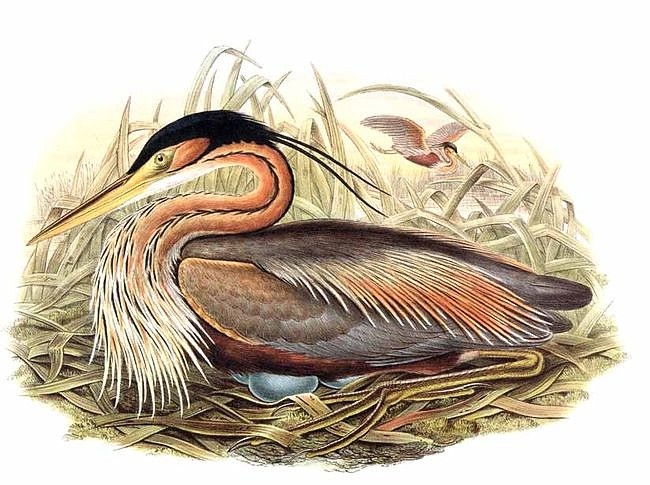
Ardea
purpurea
L'airone rosso, contrariamente a quanto suggerirebbe
il nome,
non è purpureo nella sua totalità
Ha un piumaggio le cui tinte e tonalità sono ben documentate nelle
immagini
Molto più purpureo è un fenicottero.
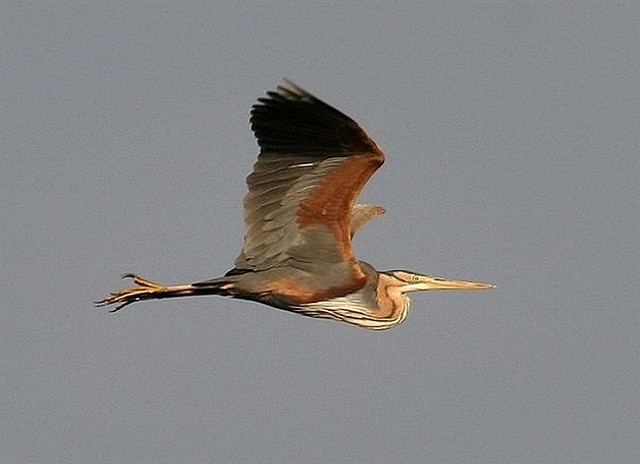
Fenicottero è il nome comune di cinque specie di uccelli con zampe eccezionalmente lunghe e collo slanciato e flessibile. I rapporti di parentela dei fenicotteri con gli altri uccelli sono incerti: per alcuni aspetti possono essere accostati agli aironi e agli ibis, mentre per altri alle anatre e alle oche; inoltre, in base ad alcuni resti fossili, potrebbero avere un rapporto di parentela anche con i trampolieri. Il becco dei fenicotteri s'incurva, a metà della sua lunghezza, bruscamente verso il basso e sui margini porta delle placche, piccole e strette, chiamate lamelle. Per nutrirsi i fenicotteri affondano la testa sott'acqua e scavano all'indietro con la testa: la grossa lingua carnosa forza l'acqua all'interno del becco e la fa fuoriuscire dal filtro rappresentato dalle lamelle, che trattengono i piccoli invertebrati e le sostanze di origine vegetale di cui l'uccello si nutre.
La più grande specie conosciuta è il fenicottero maggiore Phoenicopterus ruber. Esso ha due sottospecie alquanto diverse, Phoenicopterus ruber ruber, di colore rosso acceso, e Phoenicopterus ruber roseus, di tinte più pallide. La prima si riproduce soprattutto allo stato selvatico, ma anche in cattività, nell'area caraibica. La varietà roseus vive in Eurasia, nelle regioni mediterranee e in Africa, spingendosi a oriente fino all'India. I maschi di entrambe le sottospecie possono raggiungere 155 cm di altezza. Il fenicottero maggiore si riproduce in prossimità di acque stagnanti, su isole circondate da acque poco profonde, bacini salati e lagune, costruendo un mucchio conico di fango, sormontato da una leggera depressione nella quale viene deposto un solo uovo (raramente due). Sebbene già dopo un mese siano in grado di alimentarsi in modo autonomo, i piccoli vengono nutriti per 75 giorni con il cibo rigurgitato dai genitori.
Il fenicottero del Cile (Phoenicopterus chilensis) è leggermente più piccolo del fenicottero maggiore; è di colore rosa pallido, con strisce rosso brillante sul dorso, e nidifica sulle Ande, nei pressi di piccoli laghi salati, e nelle pianure all'estremo sud del continente americano. Due specie piccole, il fenicottero delle Ande (Phoenicopterus andinus) e il fenicottero di James (Phoenicopterus jamesi), vivono anch'esse nella regione andina. La specie più piccola e più abbondante, il fenicottero minore (Phoenicopterus minor), con una popolazione mondiale di almeno 4 milioni di individui, ha un areale che si estende dall'Africa verso oriente fino all'India.
Classificazione scientifica - I fenicotteri costituiscono la famiglia dei fenicotteridi dell'ordine dei fenicotteriformi. A volte vengono collocati nell’ ordine dei ciconiformi.
Microsoft
® Encarta ® 2006. © 1993-2005 Microsoft Corporation
Tutti i diritti riservati.

A Caribbean Flamingo Phoenicopterus ruber
with Chilean Flamingos Phoenicopterus chilensis in the background
Scientific classification
Kingdom: Animalia
Phylum: Chordata
Class: Aves
Order: Phoenicopteriformes Fürbringer, 1888
Family: Phoenicopteridae Bonaparte, 1831
Genus: Phoenicopterus Linnaeus, 1758
Flamingos are gregarious wading birds in the genus Phoenicopterus and family Phoenicopteridae. They are found in both the Western and Eastern Hemispheres, but are more numerous in the latter. There are four species in the Americas while two exist in the Old World. Two species, the Andean and the James's Flamingo, are often placed in the genus Phoenicoparrus instead of Phoenicopterus.
Systematics
Species - Geographic location
Greater
Flamingo (Phoenicopterus roseus)
- parts of Africa, S. Europe and S. and SW Asia (most widespread flamingo).
Lesser Flamingo (Phoenicopterus minor) - Africa (e.g. Great
Rift Valley) to NW India (most numerous flamingo).
Chilean Flamingo (Phoenicopterus chilensis)
- Temperate S. South America.
James's Flamingo (Phoenicopterus jamesi)
- High Andes in Peru, Chile, Bolivia and Argentina.
Andean Flamingo (Phoenicopterus andinus) - High Andes in Peru,
Chile, Bolivia and Argentina.
Caribbean Flamingo (Phoenicopterus ruber)
- Caribbean and Galapagos islands.
Evolution

Lesser Flamingos in the Ngorongoro Crater, Tanzania
The prehistory of the Phoenicopteriformes is far better researched than their systematic affinities (see below). An extinct family of peculiar "swimming flamingos", the Palaelodidae, was initially believed to be the ancestors of the Phoenicopteridae. This is nowadays rejected, as the fossil genus Elornis, apparently a true albeit primitive flamingo, is known from the Late Eocene, before any palaelodid flamingos have been recorded. A considerable number of little-known birds from the Late Cretaceous onwards are sometimes considered to be flamingo ancestors. These include the genera Torotix, Scaniornis, Gallornis, Agnopterus, Tiliornis, Juncitarsus and Kashinia; these show a mix of characters and are fairly plesiomorphic in comparison to modern birds. There exists a fairly comprehensive fossil record of the genus Phoenicopterus. The systematics of prehistoric Phoenicopteriformes known only from fossils is as follows:
Placement
unresolved
Phoeniconotius (Etadunna Late
Oligocene/Early Miocene of Lake Pitikanta, Australia)
Palaelodidae
Adelalopus (Borgloon Early
Oligocene of Hoogbutsel, Belgium)
Palaelodus (Middle Oligocene -?
Middle Pleistocene)
Megapaloelodus (Late Oligocene - Early
Pliocene)
Phoenicopteridae
Elornis (Middle? Eocene - Early
Oligocene) - includes Actiornis
Phoenicopteridae gen. et sp. indet. (Camacho
Middle? - Late Miocene? of San José, Uruguay) - see Ubilla et al. (1990)
Prehistoric
species of Phoenicopterus
Phoenicopterus croizeti (Middle Oligocene -
Middle Miocene of C Europe)
Phoenicopterus floridanus
(Early Pliocene of Florida)
Phoenicopterus stocki (Middle Pliocene of Rincón,
Mexico)
Phoenicopterus copei (Late Pleistocene of W
North America and C Mexico)
Phoenicopterus minutus (Late Pleistocene of
California, USA)
Phoenicopterus aethiopicus
Relationships
The identity of the closest relatives of the flamingos is a rather contentious issue. Traditionally, the long-legged Ciconiiformes, probably a paraphyletic assemblage, have been considered the flamingos' closest relatives and the family was included in the order. Usually the spoonbills and ibises of the Threskiornithidae were considered their closest relatives within this order. Nevertheless, relationships to the Anseriformes (waterfowl) were considered as well (Sibley et al. 1969), especially as flamingos and waterfowl are parasitized by feather lice of the genus Anaticola (Johnson et al. 2006).
To reflect the uncertainty about this matter, flamingos began to be placed in their own order later on. Other scientists proposed flamingos as waders most closely related to the stilts and avocets, Recurvirostridae. The peculiar presbyornithids were used to argue for a close relationship between flamingos, waterfowl, and waders (Feduccia 1976), but they are now known to be unequivocal waterfowl with a peculiarly derived morphology paralleling waders and flamingos.
In recent years, molecular and anatomical studies have yielded confusing results: Sibley & Monroe placed flamingos within their expanded (and certainly paraphyletic, as is now known) Ciconiiformes. On the other hand, since long it has been the grebes (Podicipedidae), rather than Ciconiiformes, ducks, or stilts, that were time and again indicated as the closest relatives of flamingos, and there is currently renewed interest in this hypothesis.
In a 2004 study comparing DNA sequences of intron 7 of the ß-fibrinogen gene (FGB-int7), the Neognathae (all living birds except the ratites and tinamous) excluding waterfowl and Galliformes were shown to be divided into two subgroups of uneven size. The first and smaller one, Metaves, contains flamingos and grebes, alongside the hoatzin, pigeons, sandgrouse, the Caprimulgiformes, the Apodiformes, tropicbirds, mesites, sunbittern and kagu. Interestingly, most of these groups have traditionally been difficult to place on the family tree of birds. According to this study, all other birds belong to the second subgroup of Neoaves, the Coronaves (Fain & Houde 2004).
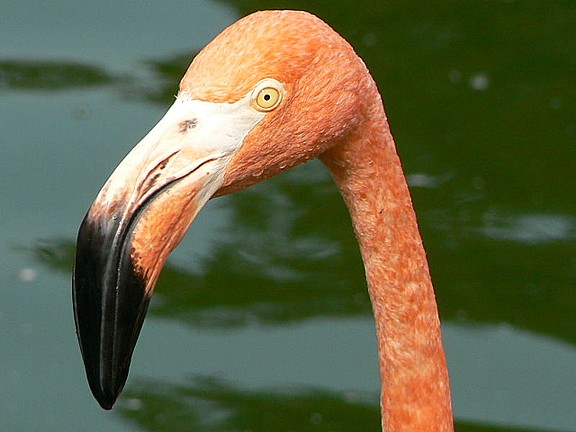
Arcuate bill is well adapted to bottom scooping
But their molecular data was insufficient to resolve inter-Metaves relationships to satisfaction; the flamingo FGB-int7 sequence is apparently most similar to that of some species of nighthawks, strongly suggesting a case of convergent evolution on the molecular level. The conclusions that one can draw from this study are twofold: first, that flamingos are Metaves (if that group is not based on molecular convergence, for which there are some indications), and second, that FBG-int7 is unsuitable to determine their relationships beyond that. It is interesting to note, however, that among all the groups which have been proposed as sister taxa of the flamingos, only the grebes are Metaves.
In conclusion, the relationships of the flamingos still cannot be resolved with any certainty, but presently a close relationship with grebes appears somewhat more likely than other proposals. For this clade, the taxon Mirandornithes ("miraculous birds" due to their extreme divergence and apomorphies) has been proposed. In summary, all this confusion serves to show that all lines of "evidence" - molecular, morphological, ecological and parasitological - are liable to yield erroneous "proof" and that no method can be considered generally superior. Any future attempt to finally resolve the flamingos' relationships, therefore, would have to employ total evidence to support it and carefully weigh the data against alternative proposals.
Physiology
Diet
Flamingos filter-feed on brine shrimp. Their oddly-shaped beaks are specially adapted to separate mud and silt from the food they consume, and are uniquely used upside-down. The filtering of food items is assisted by hairy structures called lamellae which line the mandibles, and the large rough-surfaced tongue. The flamingo's characteristic pink colouring is caused by the Beta carotene in their diet. The source of this varies by species, but shrimp and blue-green algae are common sources; zoo-fed flamingoes may be given food with the additive canthaxanthin, which is often also given to farmed salmon.
Legs
Flamingos frequently stand on one leg. The reason for this behavior is not fully known. One common theory is that tucking one leg beneath the body may conserve body heat, but this has not been proven. It is often suggested that this is done in part to keep the legs from getting wet, and in addition to conserving energy. In addition to standing in the water, flamingos may stamp their webbed feet in the mud to stir up food from the bottom.
Colour
Young flamingos hatch with grey plumage, but the feathers of an adult range from light pink to bright red due to the bacteria in the water they inhabit and the pigments obtained from their food supply. A flamingo that is well-fed and healthy is vibrantly coloured bright pink and is more desirable as a mate. A white or pale flamingo, however, is usually unhealthy or suffering from a lack of food. Notable exceptions are the flamingos in captivity, many of which turn a pale pink as they are not fed foods containing sufficient amounts of carotene. This is changing as more zoos begin to add shrimp and other supplements to the diets of their flamingos. In summary, flamingos obtain their color from a beta chloride diet.
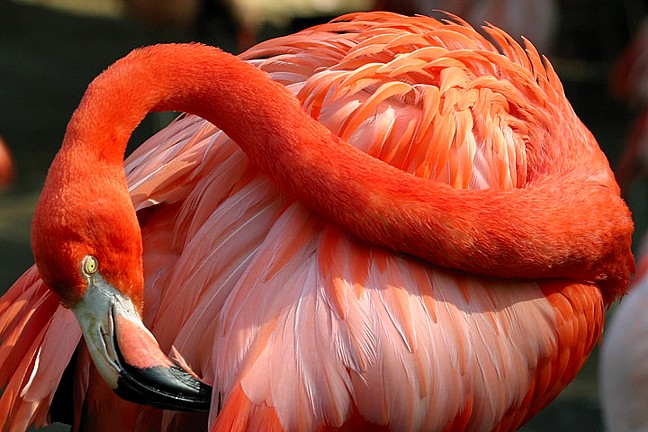
Phoenicopterus ruber
Feeding
Flamingos produce a "milk" like pigeon milk due to the action of a hormone called prolactin (see Columbidae). It contains more fat and less protein than the latter does, and it is produced in glands lining the whole of the upper digestive tract, not just the crop. Both parents nurse their chick, and young flamingos feed on this milk, which also contains red and white blood cells, for about two months until their bills are developed enough to filter feed.
Conservation status
Scientists have discovered that birds are dying by the thousand along the Rift Valley lakes of Kenya and Tanzania. However, they are baffled about the reason. Possible causes include avian cholera, botulism, metal pollution, pesticides or poisonous bacteria, say researchers. Also, fears for the future of the Lesser Flamingo — Phoeniconaias minor — have also been raised by plans to pipe water from one of their key breeding areas, the shores of Lake Natron. The lakes are crucial to the birds' breeding success because the flamingos feed off the blooms of cyanobacteria that thrive there.
Most scientific attention has focused on the environmental changes to the lakes. Water levels have lowered and concentrations of salt in the water have increased. This increases the risk of toxic bacteria growing there.
Culinary use
In Ancient Rome, flamingo tongues were considered a delicacy. Also, Andean miners have killed flamingos for their fat, believed to be a cure for tuberculosis.
Other
The Moche people of ancient Peru worshipped nature. They placed emphasis on animals and often depicted flamingos in their art.

Phoenicopterus roseus
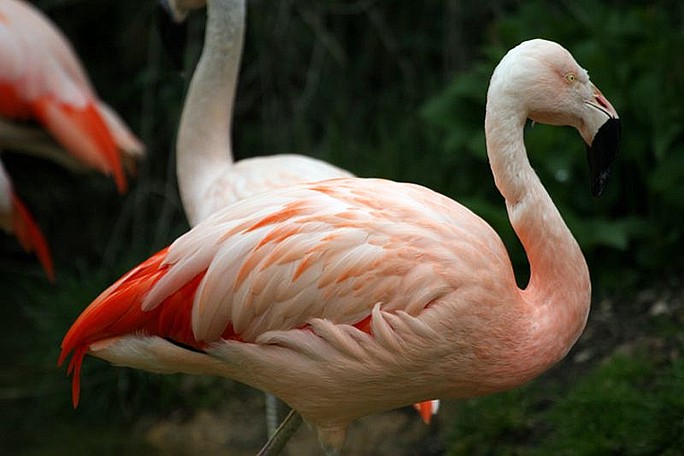
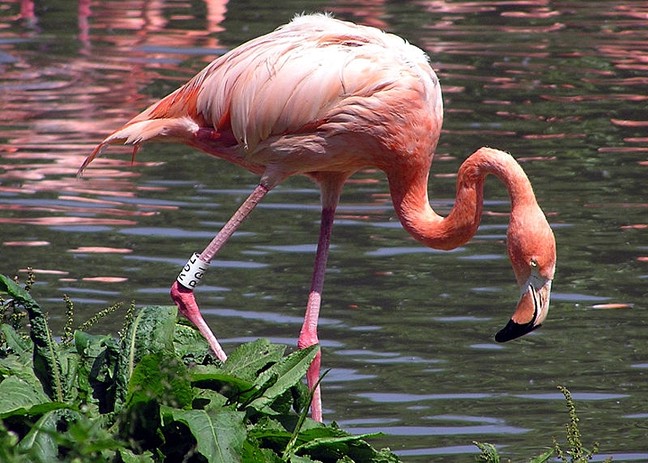
Phoenicopterus ruber
